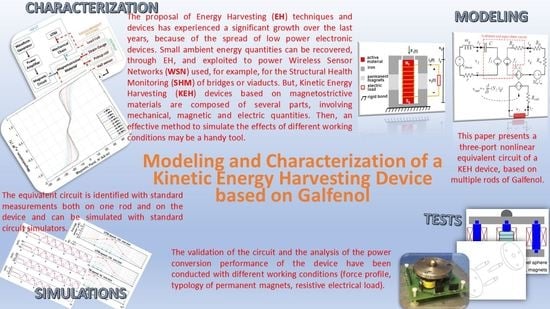Modeling and Characterization of a Kinetic Energy Harvesting Device Based on Galfenol
Abstract
1. Introduction
2. Experimental Setup and Static Magneto-Mechanical Characteristics of Galfenol
- -H are nonlinear and show narrow hysteresis loop;
- -H show saturation when ;
- is odd function of H;
- the -H cycles are self-similar with respect to the stress;
- regarding -H, if the compressive stress increases then the -H cycles drop down.
- regarding -, there is an optimum that makes largest.
3. Modelling
3.1. Analytical Model of SA Galfenol
- all mechanical input and fields are parallel to the cylinder axis;
- any transformations is isothermal;
- hysteresis phenomena is negligible;
- a fractional fourth order function in the z variable, which describes SA Galfenol behavior at low magnetic field applied and the above mentioned kinking phenomena;
- an hyperbolic function able to mimic the response for increasing magnetic field and saturation.
3.2. Three-Port Equivalent Circuit of a Single Rod KEH Device
- the active material, in this case SA Galfenol;
- a mechanical frame devoted to transfer the force to the active material;
- the magnetic circuit providing the magnetic bias to improve the harvested power;
- the coil, generally wounded around the active material, in order to exploit the Villari effect and Faraday’s law.
- all the fields are coaxial and directed along the magnetostrictive material axis, in such a way to have a scalar representation of the constitutive relationships;
- the frequency of the applied force is small enough in such a way that it can be neglected the mechanical propagation phenomena in the rod. As a consequence, any mechanical element can be modeled as lumped mass, spring, damper. Moreover, vibrations are much lower than the mechanical resonance of the structure.
- the previous point implies that the stress is assumed uniformly distributed along the rod axis;
- the electromagnetic field propagation is neglected, then the electric load is considered as a lumped element;
- the magnetic circuit is assumed to be a flux tube for the magnetic induction;
- eddy currents are negligible and magnetic circuit theory can be used to model the magnetic part.
- is the mechanical stiffness of the magnetostrictive sample;
- ;
- and are, respectively, the magnetic flux and the magnetic field in the magnetostrictive rod;
- .
- the force corresponds to a voltage, ;
- the rod tip velocity corresponds to a current, .
- ;
- the reluctance is modeled by a resistance ;
- is the flux , which flows in the reluctance rod .
4. Characterizations and Simulations of the Three Rod Device
5. Conclusions
Author Contributions
Funding
Conflicts of Interest
Abbreviations
| ICT | Information and Communications Technology |
| PDA | Personal Digital Assistant |
| WSN | Wireless Sensors Network |
| SHM | Structural Health Monitoring |
| EH | Energy Harvesting |
| IoT | Internet of Things |
| KEH | Kinetic Energy Harvesting |
| NSA | Non Stress Annealed |
| SA | Stress Annealed |
| PCB | Printed Circuit Board |
| PM | Permanent Magnet |
| RMS | Root Mean Square |
Appendix A. Identification Procedure of the Three-Rods Galfenol Keh Device Equivalent Circuit Parameters
- , , , , , are related to the proposed nonlinear model for SA Galfenol and are detailed in Section 3.1.
- , are equals because same rods have been used.
- mm and mm2 are geometric quantities of the employed rods, so directly measurable.
- GPa is the Galfenol Young Modulus, which can be determined from the material datasheet.
- , and are the nonlinear dependent voltage sources on the mechanical ports.
- , and are the nonlinear dependent voltage sources on the magnetic ports.
- , are the reluctance of the steel magnetic circuit for each rod and for the symmetry of the object have been considered equals. It can be achieved from the magnetic circuit length, section and from the magnetic characteristics of the steel. In particular, mm, and mm2.
- H−1 represents the leakage of magnetic flux between the top e bottom discs. Its value have been obtained with a minimization of the error between measured and simulated output voltages in case of optimal magnetic bias and one specific electric load inserted.
- is the reluctance of air-gap between the top steel disc and the permanent magnet. In particular, mm while the section has been considered equal to PM disc section, .
- is the reluctance of the permanent magnet. It depends only by directly measurable quantities.
- mm is the discs permanent magnet length, then directly measurable.
- is the discs permanent magnet section, then directly measurable, in particular it have been used 10, 15 and 20 mm diameter of PM.
- is the magnetization of neodymium PM and it is obtained from material datasheed (in this work it is considered equal to 1000 kA/m).
- , are the linear contribution of the total reluctance of the rods and have been considered equals.
- is the turn number of pickup coils, which is the same for each coil.
- , and , are the nonlinear dependent voltage sources on the electrical ports.
- is the pickup coil resistance are directly measurable and equals because same coils have been used.
- is the applied electrical load.
References
- Priya, S.; Inman, D.J. (Eds.) Energy Harvesting Technologies; Springer: Boston, MA, USA, 2009. [Google Scholar] [CrossRef]
- Kaźmierski, T.J.; Beeby, S. (Eds.) Energy Harvesting Systems; Springer: New York, NY, USA, 2011. [Google Scholar] [CrossRef]
- Elvin, N.; Erturk, A. Advances in Energy Harvesting Methods; Springer: Berlin/Heidelberg, Germany, 2013; p. 455. [Google Scholar]
- Chang, P.; Flatau, A.; Liu, S. Review paper: Health monitoring of civil infrastructure. Struct. Health Monit. 2003, 2, 257–267. [Google Scholar] [CrossRef]
- Lynch, J. An overview of wireless structural health monitoring for civil structures. Philos. Trans. R. Soc. A Math. Phys. Eng. Sci. 2007, 365, 345–372. [Google Scholar] [CrossRef] [PubMed]
- Balageas, D.; Fritzen, C.P.; Güemes, A. Structural Health Monitoring; John Wiley & Sons: Hoboken, NJ, USA, 2010; pp. 1–495. [Google Scholar] [CrossRef]
- Chang, F.; Markmiller, J.; Yang, J.; Kim, Y. Structural Health Monitoring. In System Health Management: With Aerospace Applications; John Wiley & Sons: Hoboken, NJ, USA, 2011; pp. 419–428. [Google Scholar] [CrossRef]
- Torfs, T.; Sterken, T.; Brebels, S.; Santana, J.; Van Den Hoven, R.; Spiering, V.; Bertsch, N.; Trapani, D.; Zonta, D. Low power wireless sensor network for building monitoring. IEEE Sens. J. 2013, 13, 909–915. [Google Scholar] [CrossRef]
- Davino, D.; Pecce, M.; Visone, C.; Clemente, C.; Ielardi, A. Dynamic monitoring of guardrails: Approach to a low-cost system. In Proceedings of the 2015 IEEE Workshop on Environmental, Energy, and Structural Monitoring Systems (EESMS), Trento, Italy, 9–10 July 2015; pp. 56–60. [Google Scholar] [CrossRef]
- Bhuiyan, M.; Wang, G.; Cao, J.; Wu, J. Deploying Wireless Sensor Networks with Fault-Tolerance for Structural Health Monitoring. IEEE Trans. Comput. 2015, 64, 382–395. [Google Scholar] [CrossRef]
- Bhuiyan, M.; Wang, G.; Wu, J.; Cao, J.; Liu, X.; Wang, T. Dependable Structural Health Monitoring Using Wireless Sensor Networks. IEEE Trans. Dependable Secur. Comput. 2017, 14, 363–376. [Google Scholar] [CrossRef]
- Park, G.; Rosing, T.; Todd, M.D.; Farrar, C.R.; Hodgkiss, W. Energy Harvesting for Structural Health Monitoring Sensor Networks. J. Infrastruct. Syst. 2008, 14, 64–79. [Google Scholar] [CrossRef]
- Basagni, S.; Naderi, M.Y.; Petrioli, C.; Spenza, D. Wireless Sensor Networks with Energy Harvesting. In Mobile Ad Hoc Networking; John Wiley & Sons: Hoboken, NJ, USA, 2013; pp. 701–736. [Google Scholar] [CrossRef]
- Shaikh, F.K.; Zeadally, S. Energy harvesting in wireless sensor networks: A comprehensive review. Renew. Sustain. Energy Rev. 2016, 55, 1041–1054. [Google Scholar] [CrossRef]
- Davino, D.; Visone, C.; Giustiniani, A. Vibration energy harvesting devices based on magnetostrictive materials. In Proceedings of the Sixth International Conference on Bridge Maintenance, Safety and Management, Stresa, Italy, 2–12 July 2012; pp. 1511–1518. [Google Scholar]
- Clemente, C.S.; Davino, D.; Maddaloni, G.; Pecce, M.R.; Visone, C. A Magnetostrictive Energy Harvesting System for Bridge Structural Health Monitoring. Adv. Sci. Technol. 2016, 101, 20–25. [Google Scholar] [CrossRef]
- Clemente, C.S.; Davino, D.; Visone, C. Experimental Characterization of a Three-Rod Magnetostrictive Device for Energy Harvesting. IEEE Trans. Magn. 2017, 53, 1–4. [Google Scholar] [CrossRef]
- Varadan, V.; Vinoy, K.; Gopalakrishnan, S. Smart Material Systems and MEMS: Design and Development Methodologies; John Wiley & Sons: Hoboken, NJ, USA, 2006; pp. 1–404. [Google Scholar] [CrossRef]
- Engdahl, G. (Ed.) Handbook of Giant Magnetostrictive Materials; Academic Press: San Diego, CA, USA, 2000; pp. 1–386. [Google Scholar] [CrossRef]
- Zhao, X.; Lord, D. Application of the Villari effect to electric power harvesting. J. Appl. Phys. 2006, 99. [Google Scholar] [CrossRef]
- Davino, D.; Giustiniani, A.; Visone, C. Capacitive load effects on a magnetostrictive fully coupled energy harvesting device. IEEE Trans. Magn. 2009, 45, 4108–4111. [Google Scholar] [CrossRef]
- Bottauscio, O.; Roccato, P.; Zucca, M. Modeling the dynamic behavior of magnetostrictive actuators. IEEE Trans. Magn. 2010, 46, 3022–3028. [Google Scholar] [CrossRef]
- Bottauscio, O.; Roccato, P.; Zucca, M. Micropositioning through magnetostrictive actuators. Sens. Lett. 2013, 11, 87–90. [Google Scholar] [CrossRef]
- Atulasimha, J.; Flatau, A. A review of magnetostrictive iron-gallium alloys. Smart Mater. Struct. 2011, 20. [Google Scholar] [CrossRef]
- Davino, D.; Giustiniani, A.; Visone, C.; Adly, A. Energy harvesting tests with galfenol at variable magneto-mechanical conditions. IEEE Trans. Magn. 2012, 48, 3096–3099. [Google Scholar] [CrossRef]
- Clemente, C.; Mahgoub, A.; Davino, D.; Visone, C. Multiphysics circuit of a magnetostrictive energy harvesting device. J. Intell. Mater. Syst. Struct. 2017, 28, 2317–2330. [Google Scholar] [CrossRef]
- Restorff, J.; Wun-Fogle, M.; Clark, A.; Hathaway, K. Induced magnetic anisotropy in stress-annealed galfenol alloys. IEEE Trans. Magn. 2006, 42, 3087–3089. [Google Scholar] [CrossRef]
- Wun-Fogle, M.; Restorff, J.; Clark, A. Magnetostriction of stress-annealed Fe-Ga and Fe-Ga-Al alloys under compressive and tensile stress. J. Intell. Mater. Syst. Struct. 2006, 17, 117–122. [Google Scholar] [CrossRef]
- Apicella, V.; Clemente, C.; Davino, D.; Visone, C. Experimental evaluation of external and built-in stress in Galfenol rods. Phys. B: Condens. Matter 2018, 549, 53–57. [Google Scholar] [CrossRef]
- TdVib LLC. TdVib Website. Available online: http://tdvib.com/ (accessed on 28 August 2019).
- Moffett, M.; Linberg, J.; McLaughlin, E. Characterization of Terfenol-D for magnetostrictive transducers. J. Acoust. Soc. Am. 1991, 89, 1448–1455. [Google Scholar] [CrossRef]
- Atulasimha, J.; Flatau, A. Experimental actuation and sensing behavior of single-crystal iron-gallium alloys. J. Intell. Mater. Syst. Struct. 2008, 19, 1371–1381. [Google Scholar] [CrossRef]
- Jin, Y.; Gu, S.; Bennett, L.; Della Torre, E.; Provenzano, V.; Zhao, Q. Self-similarity in (∂M/∂T)H curves for magnetocaloric materials with ferro-to-paramagnetic phase transitions. J. Appl. Phys. 2012, 111. [Google Scholar] [CrossRef]
- Davino, D.; Giustiniani, A.; Visone, C. Magnetoelastic Energy Harvesting: Modeling and Experiments. In Smart Actuation and Sensing Systems—Recent Advances and Future Challenges; InTech: London, UK, 2012. [Google Scholar] [CrossRef]
- Erturk, A.; Inman, D. Issues in mathematical modeling of piezoelectric energy harvesters. Smart Mater. Struct. 2008, 17. [Google Scholar] [CrossRef]
- Berbyuk, V. Towards dynamics of controlled multibody systems with magnetostrictive transducers. Multibody Syst. Dyn. 2007, 18, 203–216. [Google Scholar] [CrossRef]
- Davino, D.; Giustiniani, A.; Visone, C. Analysis of a magnetostrictive power harvesting device with hysteretic characteristics. J. Appl. Phys. 2009, 105. [Google Scholar] [CrossRef]
- Cao, S.; Zheng, J.; Guo, Y.; Li, Q.; Sang, J.; Wang, B.; Yan, R. Dynamic characteristics of galfenol cantilever energy harvester. IEEE Trans. Magn. 2015, 51. [Google Scholar] [CrossRef]
- Wan, Y.; Fang, D.; Hwang, K.C. Non-linear constitutive relations for magnetostrictive materials. Int. J. Non-Linear Mech. 2003, 38, 1053–1065. [Google Scholar] [CrossRef]
- Davino, D.; Krejčí, P.; Visone, C. Fully coupled modeling of magneto-mechanical hysteresis through ‘thermodynamic’ compatibility. Smart Mater. Struct. 2013, 22. [Google Scholar] [CrossRef]
- Davino, D.; Giustiniani, A.; Visone, C. A two-port nonlinear model for magnetoelastic energy- harvesting devices. IEEE Trans. Ind. Electron. 2011, 58, 2556–2564. [Google Scholar] [CrossRef]
- Sun, L.; Zheng, X. Numerical simulation on coupling behavior of Terfenol-D rods. Int. J. Solids Struct. 2006, 43, 1613–1623. [Google Scholar] [CrossRef]
- Ovichi, M.; Elbidweihy, H.; Torre, E.; Bennett, L.; Ghahremani, M.; Johnson, F.; Zou, M. Magnetocaloric effect in NiMnInSi Heusler alloys. J. Appl. Phys. 2015, 117. [Google Scholar] [CrossRef]
- Palumbo, S.; Rasilo, P.; Zucca, M. Experimental investigation on a Fe-Ga close yoke vibrational harvester by matching magnetic and mechanical biases. J. Magn. Magn. Mater. 2019, 469, 354–363. [Google Scholar] [CrossRef]
- Technology, L. LTspice Circuit Simulator. 2017. Available online: http://www.linear.com/designtools/software/ (accessed on 28 August 2019).
- Williams, C.; Yates, R. Analysis of a micro-electric generator for microsystems. Sens. Actuators A Phys. 1996, 52, 8–11. [Google Scholar] [CrossRef]
- Yang, Y.; Tang, L. Equivalent circuit modeling of piezoelectric energy harvesters. J. Intell. Mater. Syst. Struct. 2009, 20, 2223–2235. [Google Scholar] [CrossRef]
- Berbyuk, V. Vibration energy harvesting using Galfenol based transducer. In Proceedings of the Active and Passive Smart Structures and Integrated Systems, San Diego, CA, USA, 10–14 March 2013; Volume 8688. [Google Scholar] [CrossRef]
- Ahmed, U.; Jeronen, J.; Zucca, M.; Palumbo, S.; Rasilo, P. Finite element analysis of magnetostrictive energy harvesting concept device utilizing thermodynamic magneto-mechanical model. J. Magn. Magn. Mater. 2019, 486. [Google Scholar] [CrossRef]
- Viola, A.; Franzitta, V.; Cipriani, G.; Di Dio, V.; Raimondi, F.; Trapanese, M. A Magnetostrictive Electric Power Generator for Energy Harvesting From Traffic: Design and Experimental Verification. IEEE Trans. Magn. 2015, 51. [Google Scholar] [CrossRef]
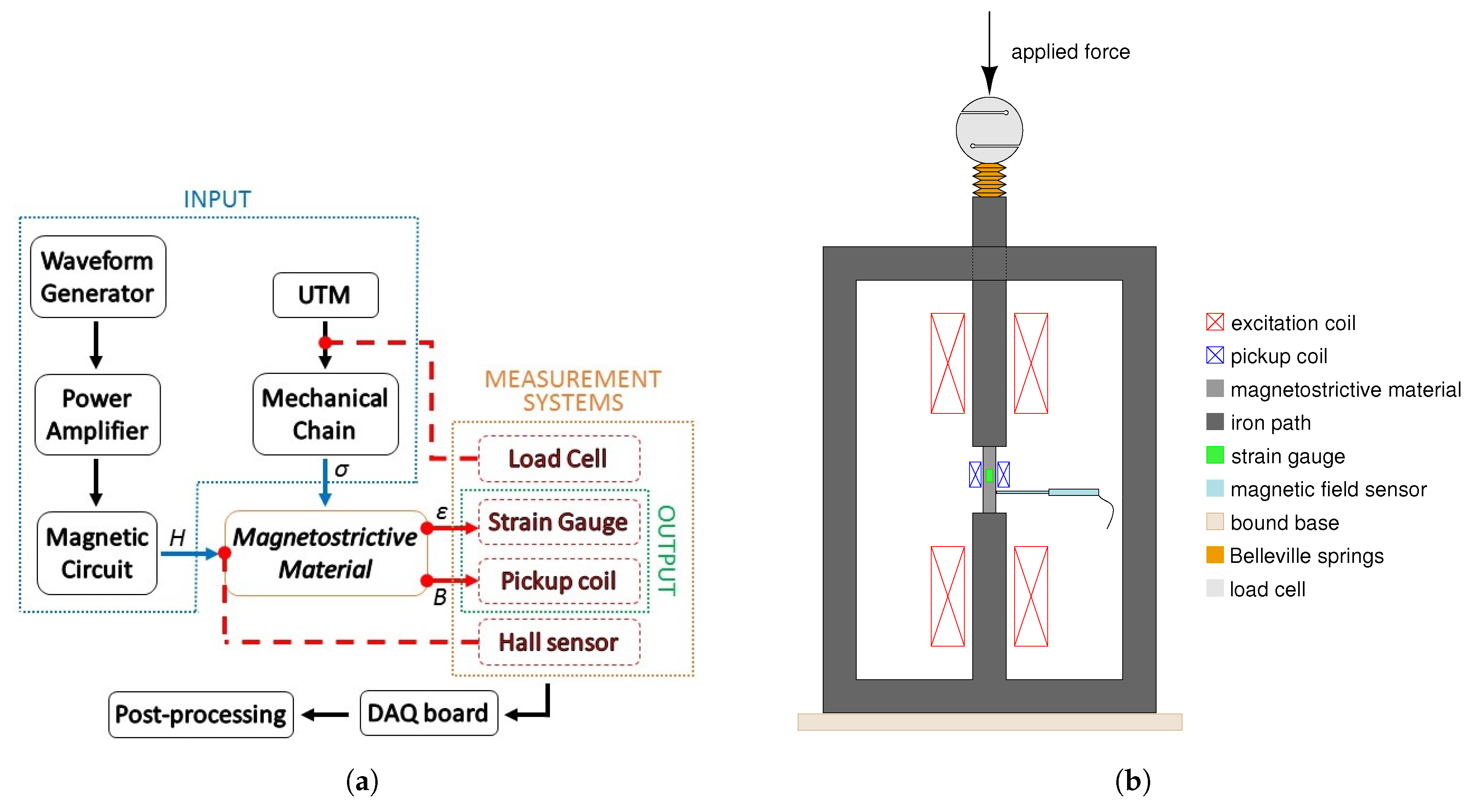
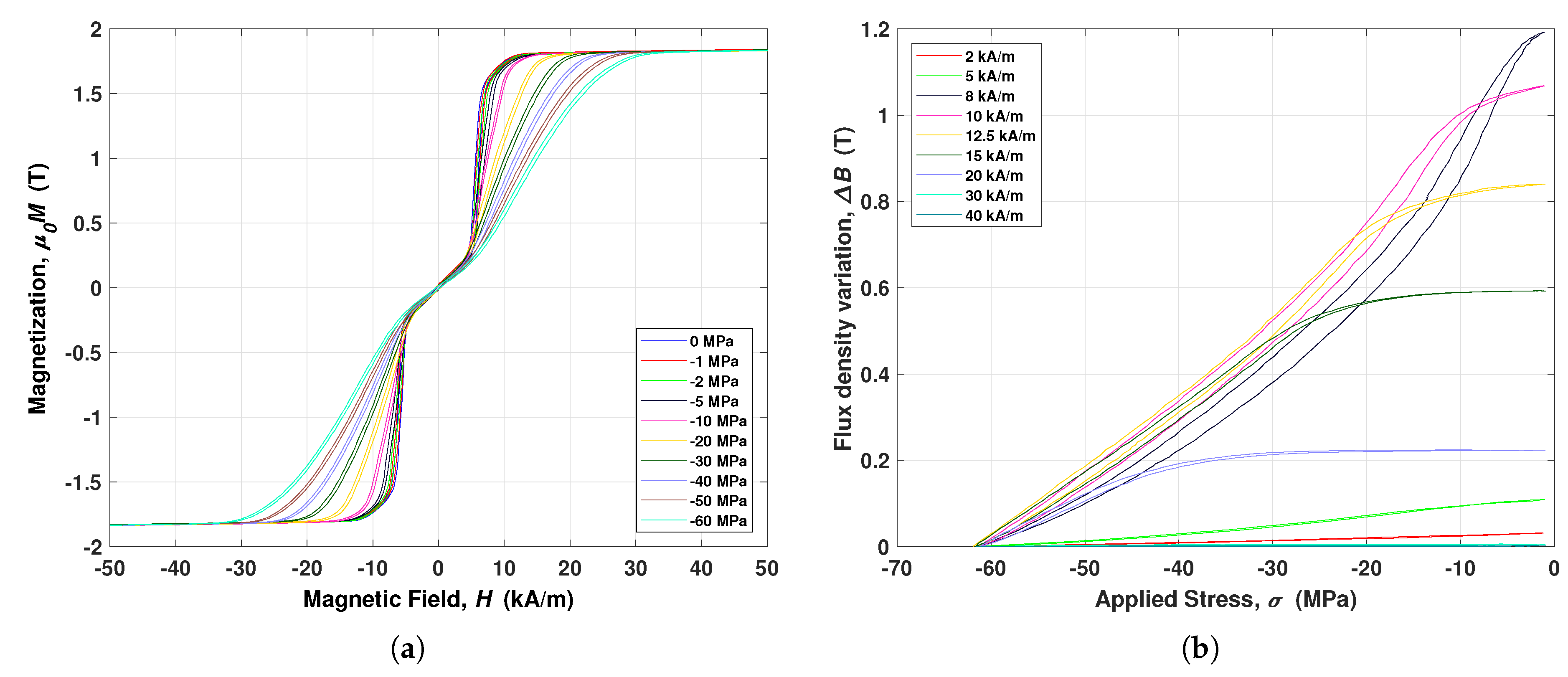
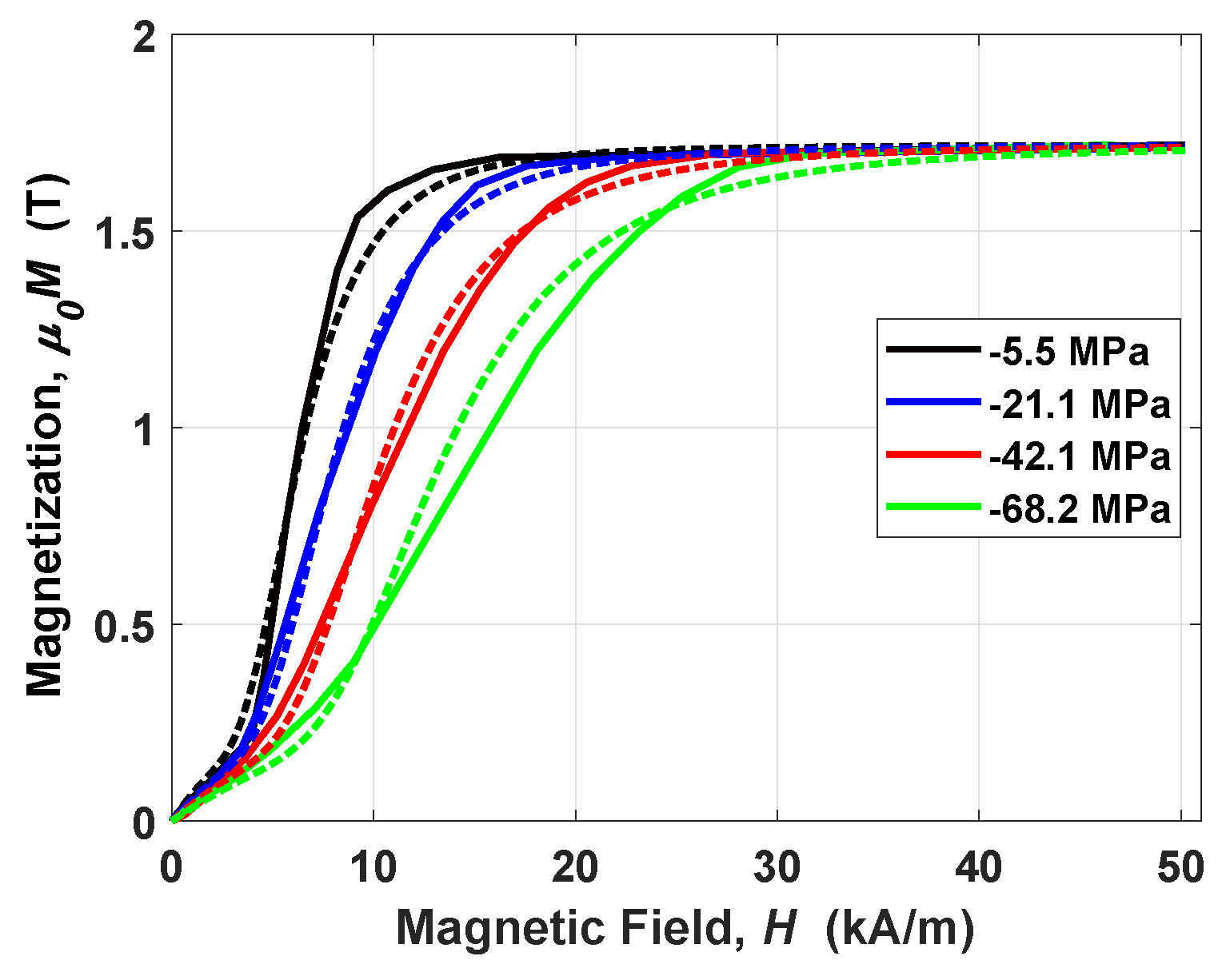
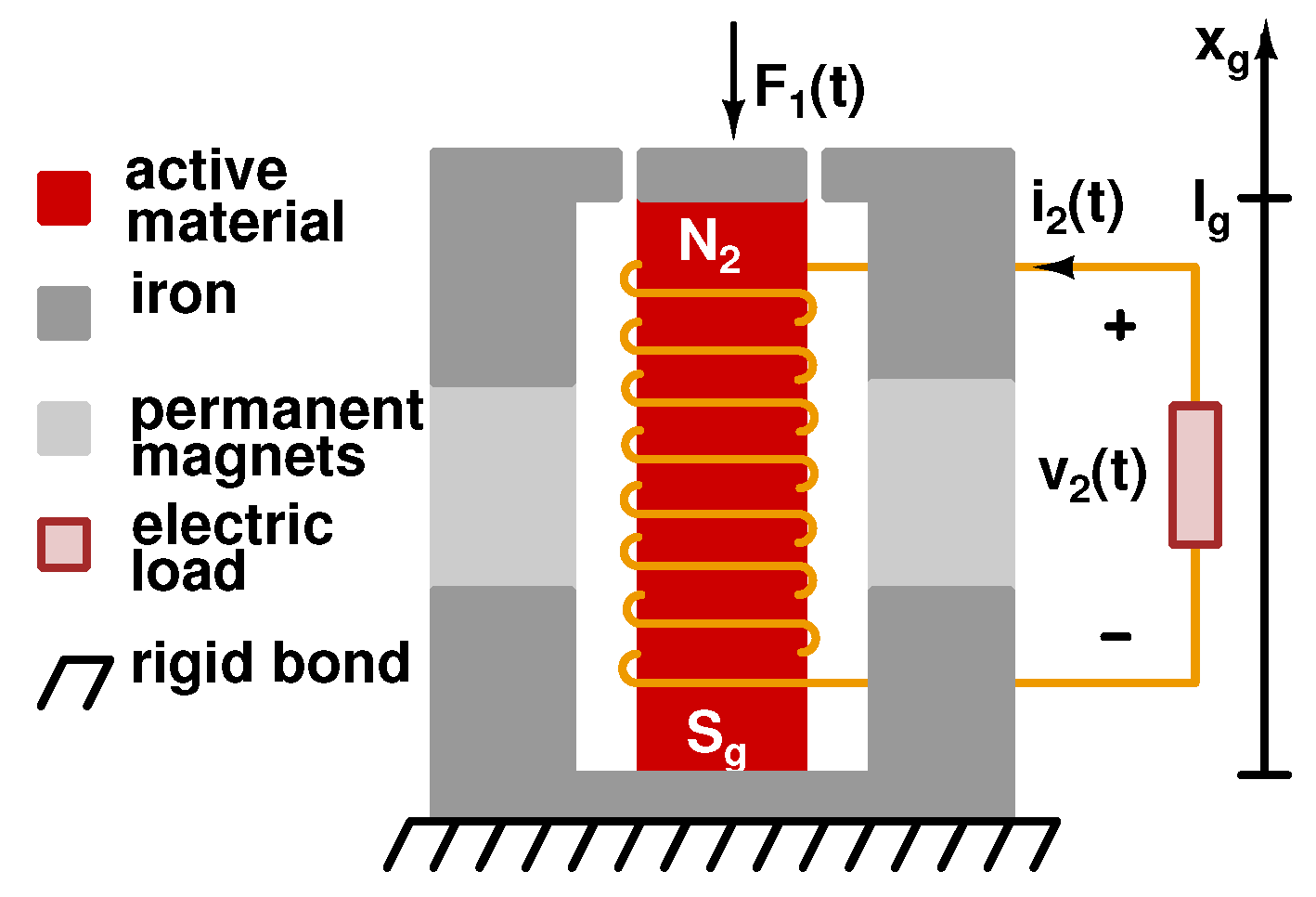

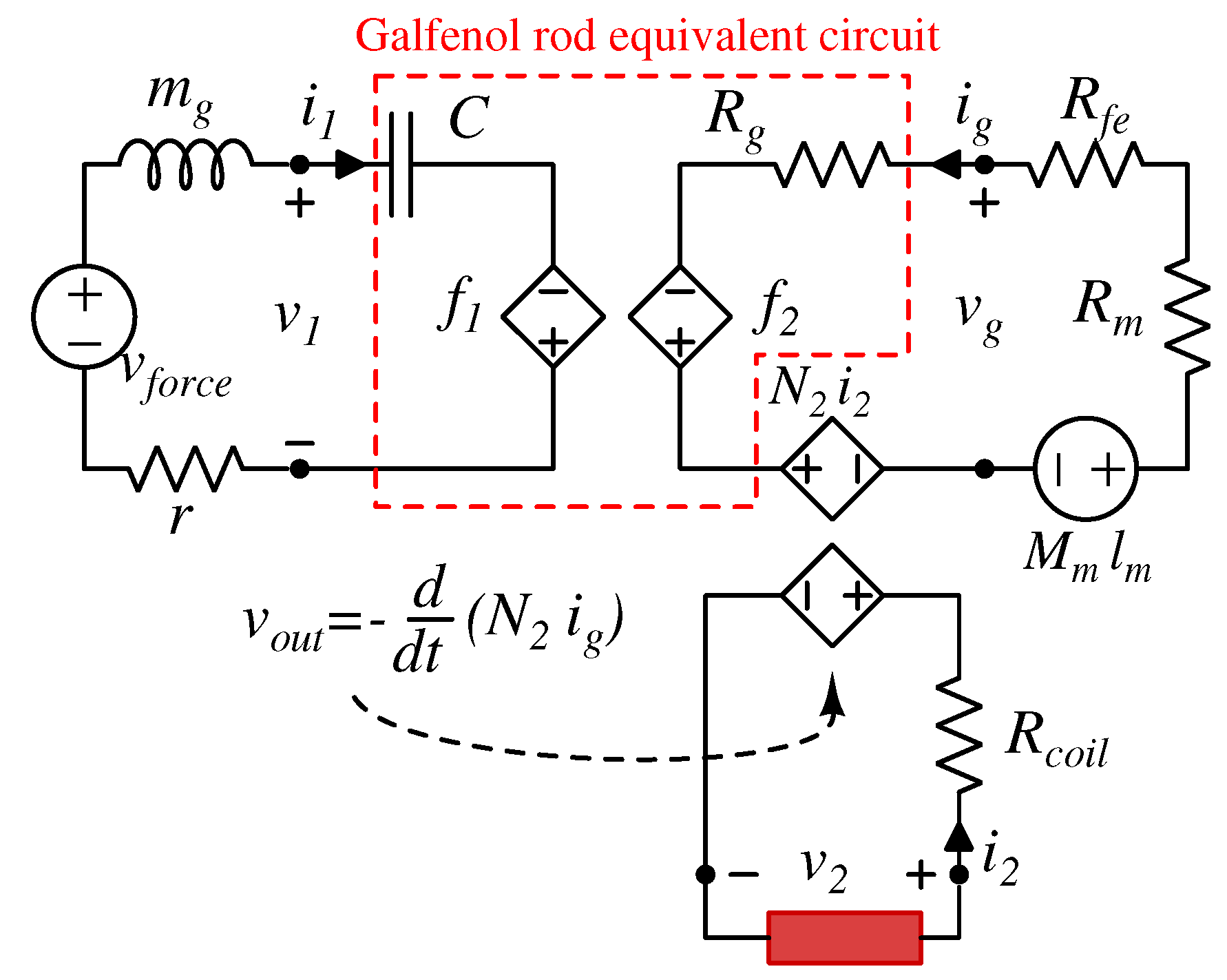
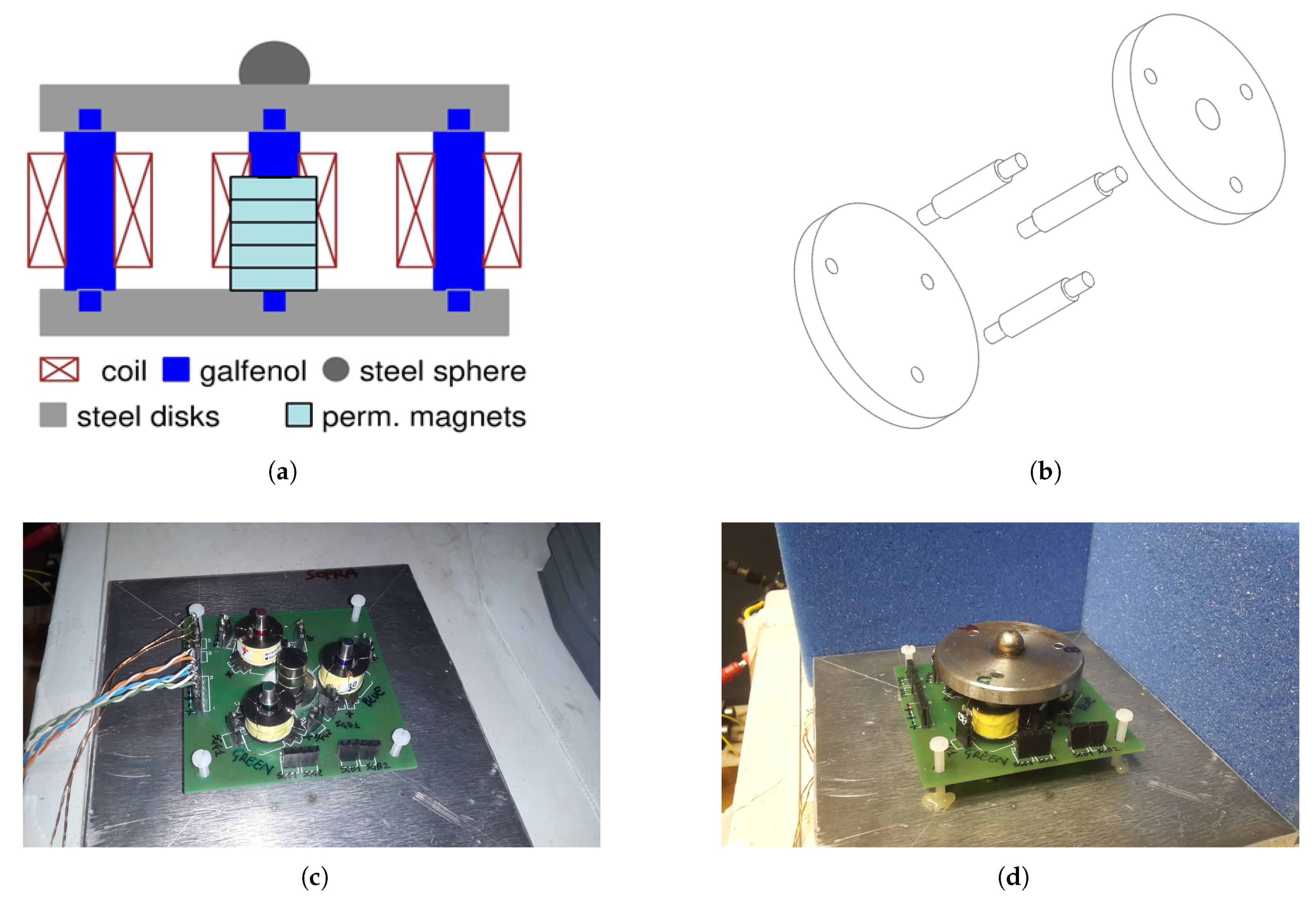
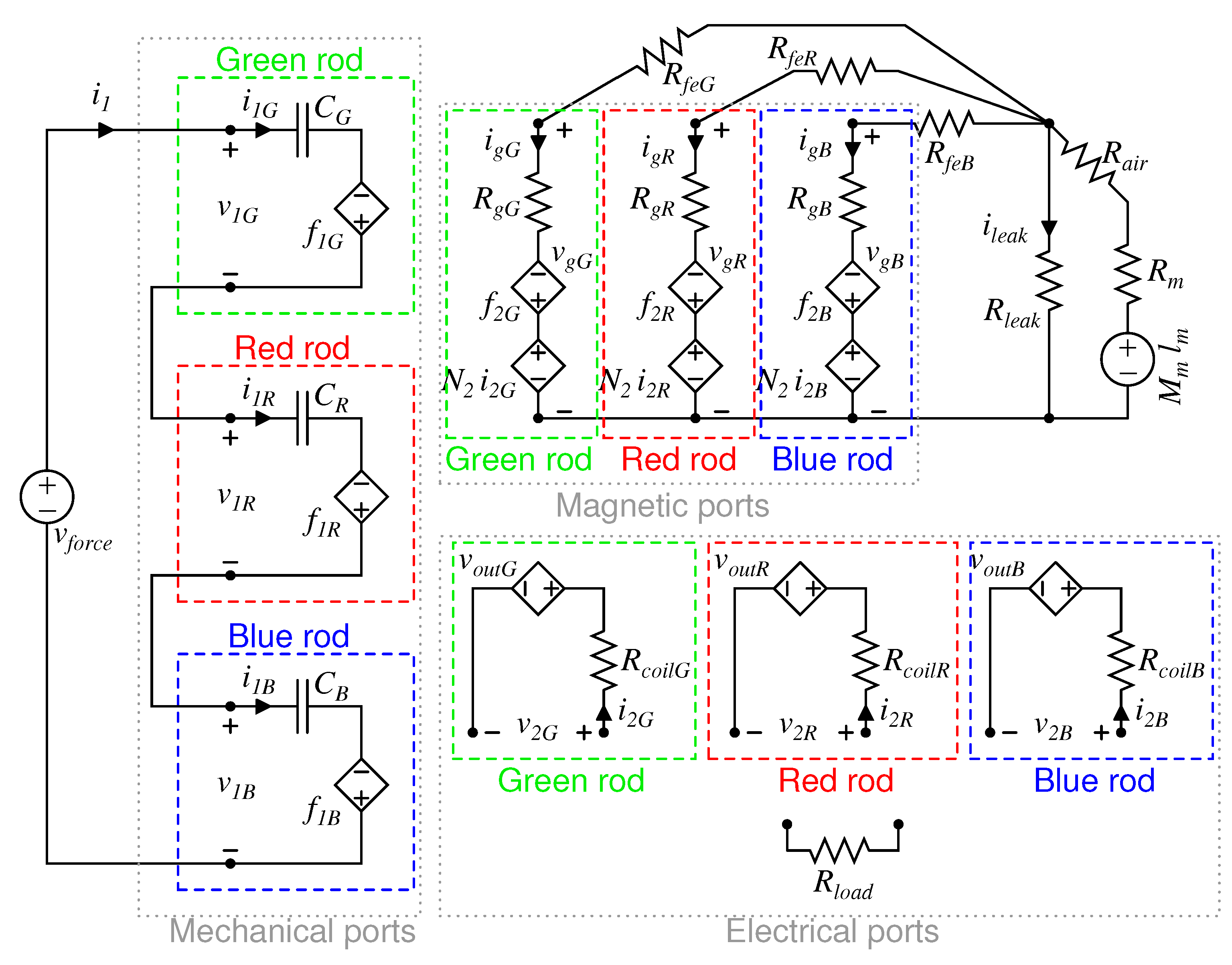

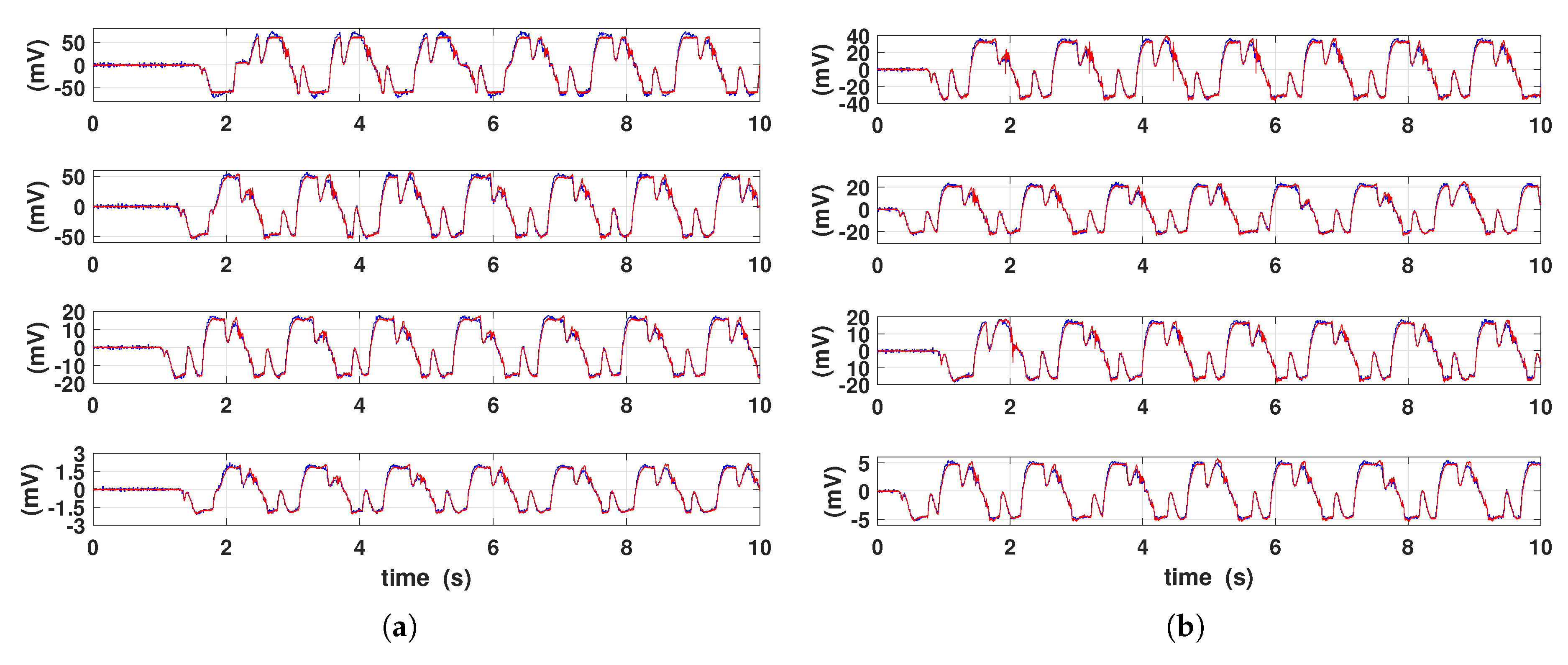

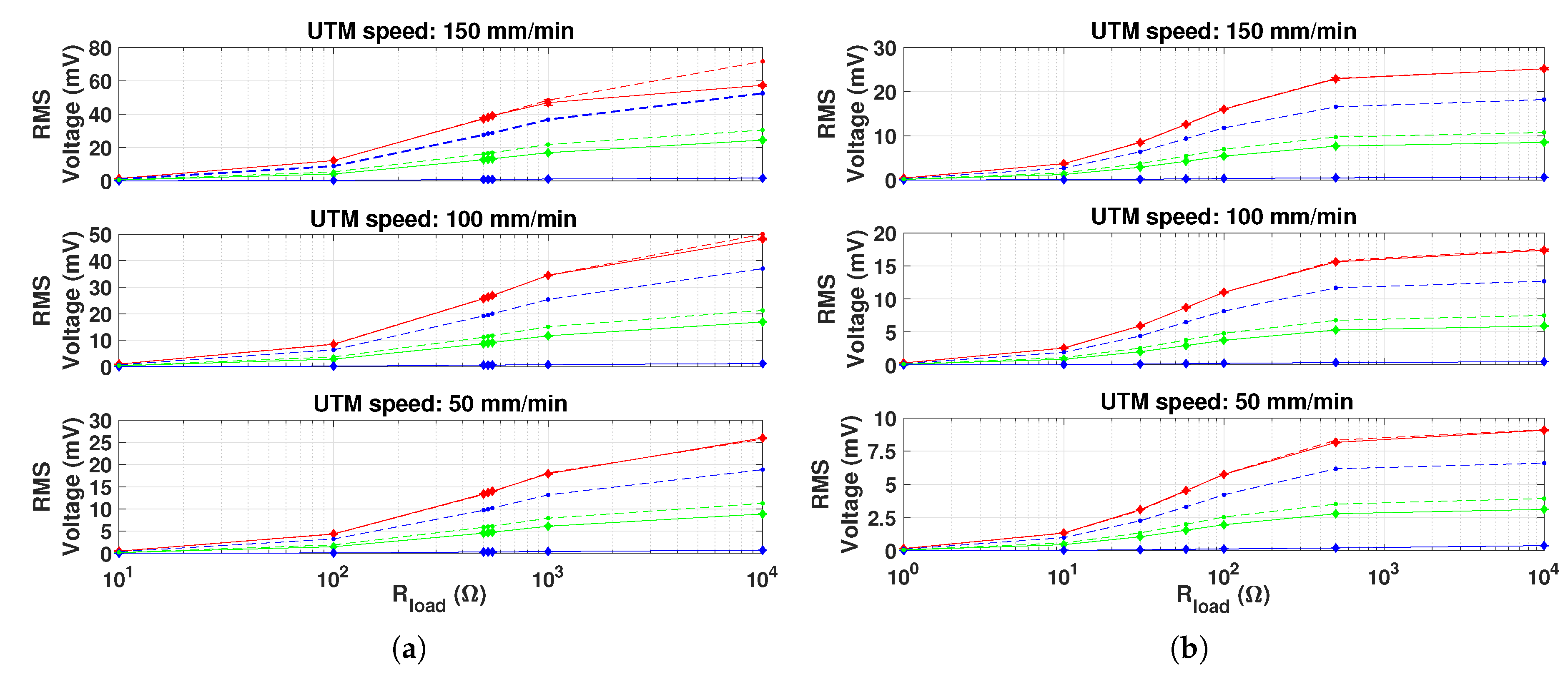

| Standard Composition | Fe81.6Ga18.4 |
|---|---|
| Mechanical Properties | |
| Density | 7800 kg/m3 |
| Young’s Modulus at constant I | 40–60 GPa |
| Young’s Modulus at constant V | 60–80 GPa |
| Bulk Modulus | 125 GPa |
| Speed of Sound | 2265–2775 m/s |
| Tensile Strength | 350 MPa |
| Fatigue Strength | 75 MPa fully reversed |
| Minimum Laminate Thickness | 0.25 mm |
| Thermal Properties | |
| Thermal expansion coefficient | 11 ppm/°C at 25 °C |
| Thermal Conductivity | 15–20 W/(mK) at 25 °C |
| Melting Point | 1450 °C |
| Electrical Properties | |
| Resistivity | 85 × 10−8 Ωm |
| Curie Temperature | 670 °C |
| Magnetostrictive Properties | |
| Strain (estimated linear) | 200–250 ppm |
| Energy Density | 0.3–0.6 kJ/m3 |
| Piezomagnetic Constant, d33 | 20–30 nm/A |
| Magnetomechanical Properties | |
| Coupling Factor | 0.6–0.7 |
| Magnetic Properties | |
| Relative Permeability | 75–100 |
| Saturating Magnetic Field | 8–20 kA/m |
| Coercivity, Hc | ∼800 A/m |
| Hysteresis (major loop) | 1000 J/m3 |
| Saturation Flux Density | 1.5–1.6 T |
© 2019 by the authors. Licensee MDPI, Basel, Switzerland. This article is an open access article distributed under the terms and conditions of the Creative Commons Attribution (CC BY) license (http://creativecommons.org/licenses/by/4.0/).
Share and Cite
Clemente, C.S.; Davino, D. Modeling and Characterization of a Kinetic Energy Harvesting Device Based on Galfenol. Materials 2019, 12, 3199. https://doi.org/10.3390/ma12193199
Clemente CS, Davino D. Modeling and Characterization of a Kinetic Energy Harvesting Device Based on Galfenol. Materials. 2019; 12(19):3199. https://doi.org/10.3390/ma12193199
Chicago/Turabian StyleClemente, Carmine Stefano, and Daniele Davino. 2019. "Modeling and Characterization of a Kinetic Energy Harvesting Device Based on Galfenol" Materials 12, no. 19: 3199. https://doi.org/10.3390/ma12193199
APA StyleClemente, C. S., & Davino, D. (2019). Modeling and Characterization of a Kinetic Energy Harvesting Device Based on Galfenol. Materials, 12(19), 3199. https://doi.org/10.3390/ma12193199





